中国保险市场2003年概况及展望
- 格式:doc
- 大小:231.50 KB
- 文档页数:21
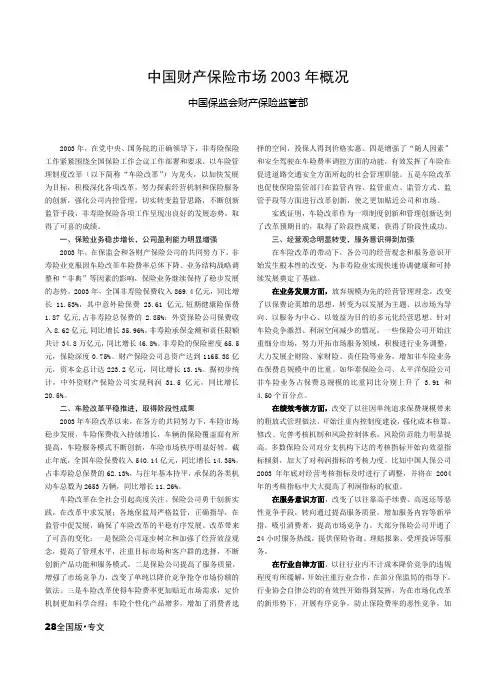
中国财产保险市场2003年概况中国保监会财产保险监管部2003年,在党中央、国务院的正确领导下,非寿险保险工作紧紧围绕全国保险工作会议工作部署和要求,以车险管理制度改革(以下简称“车险改革”)为龙头,以加快发展为目标,积极深化各项改革,努力探索经营机制和保险服务的创新,强化公司内控管理,切实转变监管思路,不断创新监管手段,非寿险保险各项工作呈现出良好的发展态势,取得了可喜的成绩。
一、保险业务稳步增长,公司盈利能力明显增强2003年,在保监会和各财产保险公司的共同努力下,非寿险业克服因车险改革车险费率总体下降、业务结构战略调整和“非典”等因素的影响,保险业务继续保持了稳步发展的态势。
2003年,全国非寿险保费收入869.4亿元,同比增长11.53%,其中意外险保费23.61亿元,短期健康险保费1.87亿元,占非寿险总保费的2.85%;外资保险公司保费收入8.62亿元,同比增长35.96%。
非寿险承保金额和责任限额共计34.8万亿元,同比增长46.8%。
非寿险的保险密度65.5元,保险深度0.75%。
财产保险公司总资产达到1165.38亿元,资本金总计达223.2亿元,同比增长13.1%。
据初步统计,中外资财产保险公司实现利润31.5亿元,同比增长20.5%。
二、车险改革平稳推进,取得阶段性成果2003年车险改革以来,在各方的共同努力下,车险市场稳步发展,车险保费收入持续增长,车辆的保险覆盖面有所提高,车险服务模式不断创新,车险市场秩序明显好转。
截止年底,全国车险保费收入540.14亿元,同比增长14.35%,占非寿险总保费的62.13%,与往年基本持平,承保的各类机动车总数为2653万辆,同比增长11.26%。
车险改革在全社会引起高度关注。
保险公司勇于创新实践,在改革中求发展;各地保监局严格监管,正确指导,在监管中促发展,确保了车险改革的平稳有序发展。
改革带来了可喜的变化:一是保险公司逐步树立和加强了经营效益观念,提高了管理水平,注重目标市场和客户群的选择,不断创新产品功能和服务模式。
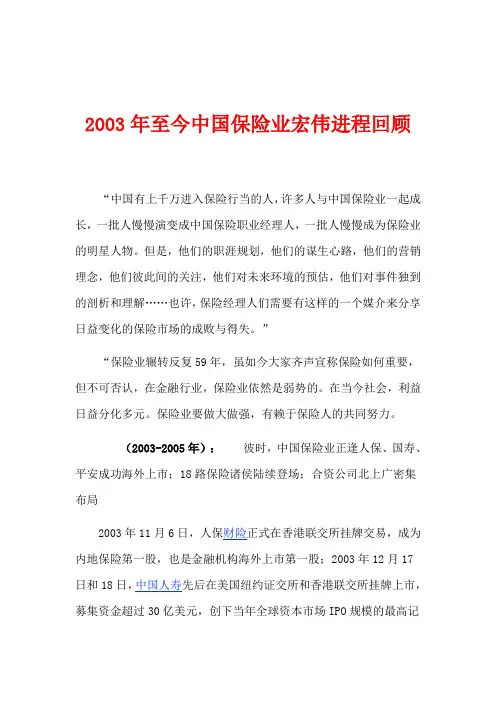
2003年至今中国保险业宏伟进程回顾“中国有上千万进入保险行当的人,许多人与中国保险业一起成长,一批人慢慢演变成中国保险职业经理人,一批人慢慢成为保险业的明星人物。
但是,他们的职涯规划,他们的谋生心路,他们的营销理念,他们彼此间的关注,他们对未来环境的预估,他们对事件独到的剖析和理解……也许,保险经理人们需要有这样的一个媒介来分享日益变化的保险市场的成败与得失。
”“保险业辗转反复59年,虽如今大家齐声宣称保险如何重要,但不可否认,在金融行业,保险业依然是弱势的。
在当今社会,利益日益分化多元。
保险业要做大做强,有赖于保险人的共同努力。
(2003-2005年):彼时,中国保险业正逢人保、国寿、平安成功海外上市;18路保险诸侯陆续登场;合资公司北上广密集布局2003年11月6日,人保财险正式在香港联交所挂牌交易,成为内地保险第一股,也是金融机构海外上市第一股;2003年12月17日和18日,中国人寿先后在美国纽约证交所和香港联交所挂牌上市,募集资金超过30亿美元,创下当年全球资本市场IPO规模的最高记录;2004年6月24日,平安保险集团股票在香港联交所正式挂牌交易,创下集团整体上市先例。
2004年7月底,中国保监会尘封8年的中资保险公司审批大印重新开启,在提交的30余份申请中,最终经保监会办公会议审批获准筹建的共有18家新设独立中资保险公司,即所谓“8+3+7”(8家寿险、3家健康险、7家财产险)。
18家获批公司的名单是:国民人寿、平泰人寿、昭德人寿、华夏人寿、联合人寿、国信人寿、国华人寿、阳光健康险、昆仑健康险、正华健康险、永诚财险、华农财险、安邦财险、安华农业险、万全汽车险、渤海财险、东安财险等。
当时引起市场热议的还有这18家公司的股东或多或少有民营背景这一共同标签。
几经沉浮,这些公司大多数现已更名。
与上述18家新设独立中资保险公司几乎同时获批的还有人保健康险、平安健康险、太平养老险、平安养老险等专业公司,以及华泰人寿、华泰资产管理、中再寿险、中国再资产管理等集团公司附属的子公司。
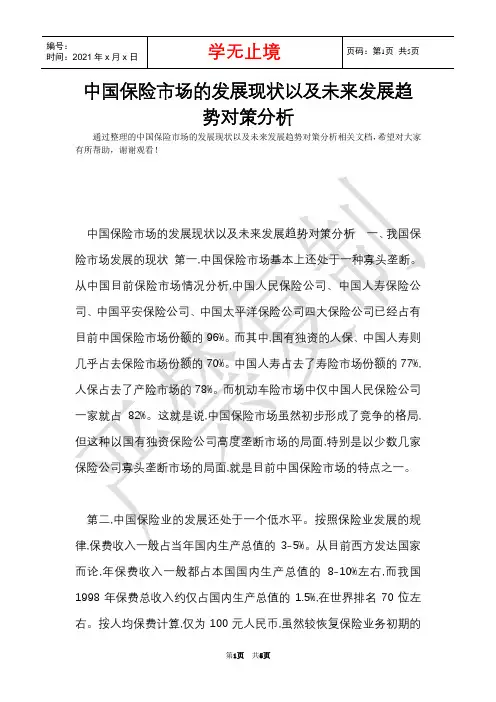
中国保险市场的发展现状以及未来发展趋势对策分析通过整理的中国保险市场的发展现状以及未来发展趋势对策分析相关文档,希望对大家有所帮助,谢谢观看!中国保险市场的发展现状以及未来发展趋势对策分析一、我国保险市场发展的现状第一,中国保险市场基本上还处于一种寡头垄断。
从中国目前保险市场情况分析,中国人民保险公司、中国人寿保险公司、中国平安保险公司、中国太平洋保险公司四大保险公司已经占有目前中国保险市场份额的96%。
而其中,国有独资的人保、中国人寿则几乎占去保险市场份额的70%。
中国人寿占去了寿险市场份额的77%,人保占去了产险市场的78%。
而机动车险市场中仅中国人民保险公司一家就占82%。
这就是说,中国保险市场虽然初步形成了竞争的格局,但这种以国有独资保险公司高度垄断市场的局面,特别是以少数几家保险公司寡头垄断市场的局面,就是目前中国保险市场的特点之一。
第二,中国保险业的发展还处于一个低水平。
按照保险业发展的规律,保费收入一般占当年国内生产总值的3-5%。
从目前西方发达国家而论,年保费收入一般都占本国国内生产总值的8-10%左右,而我国1998年保费总收入约仅占国内生产总值的1.5%,在世界排名70位左右。
按人均保费计算,仅为100元人民币,虽然较恢复保险业务初期的人均不到10元人民币已有翻天覆地的变化,但仍在世界排名第80位左右。
当然,我们要达到西方发达国家人均保费2000多美元的水平还有距离。
因为,从总体上来说,我们的经济还不发达,人均收入水平较低,但同时又说明在建立完善的市场经济体系过程中,中国居民的保险意识与投资意识还要有一个提高过程。
第三,中国保险市场结构分布不均衡。
从目前中国保险公司机构的分布而论,30家中外保险公司的总部基本上都设置在北京和中国沿海城市。
保险公司分支机构虽然在大陆已普遍设立,但多数又集中在人口密集、经济发达的地区和城市,这就造成了保险市场发育不均衡性。
第四,中国保险业的专业经营水平还不高。
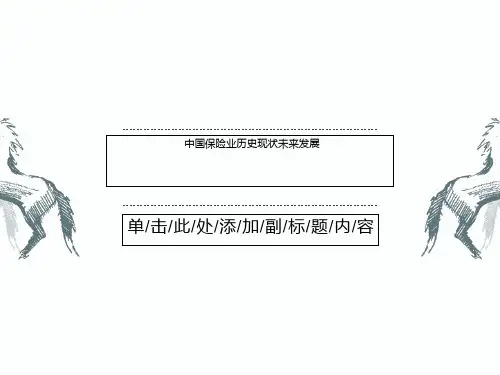
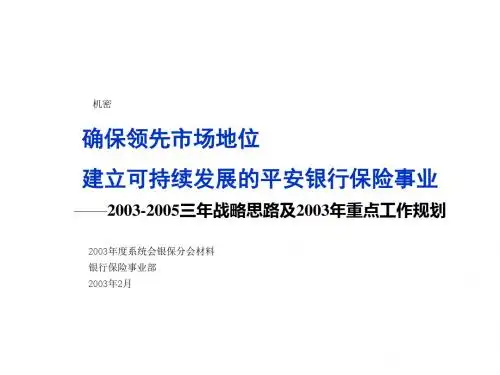
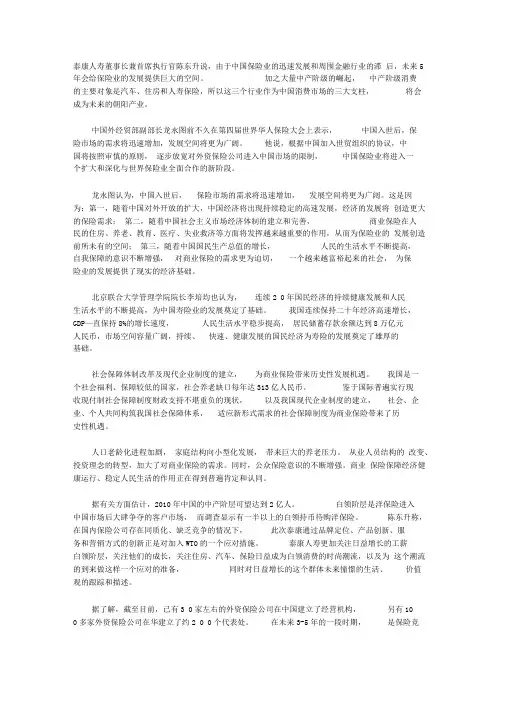
泰康人寿董事长兼首席执行官陈东升说,由于中国保险业的迅速发展和周围金融行业的滞后,未来5年会给保险业的发展提供巨大的空间。
加之大量中产阶级的崛起,中产阶级消费的主要对象是汽车、住房和人寿保险,所以这三个行业作为中国消费市场的三大支柱,将会成为未来的朝阳产业。
中国外经贸部副部长龙永图前不久在第四届世界华人保险大会上表示,中国入世后,保险市场的需求将迅速增加,发展空间将更为广阔。
他说,根据中国加入世贸组织的协议,中国将按照审慎的原则,逐步放宽对外资保险公司进入中国市场的限制,中国保险业将进入一个扩大和深化与世界保险业全面合作的新阶段。
龙永图认为,中国入世后,保险市场的需求将迅速增加,发展空间将更为广阔。
这是因为:第一,随着中国对外开放的扩大,中国经济将出现持续稳定的高速发展,经济的发展将创造更大的保险需求;第二,随着中国社会主义市场经济体制的建立和完善,商业保险在人民的住房、养老、教育、医疗、失业救济等方面将发挥越来越重要的作用,从而为保险业的发展创造前所未有的空间;第三,随着中国国民生产总值的增长,人民的生活水平不断提高,自我保障的意识不断增强,对商业保险的需求更为迫切,一个越来越富裕起来的社会,为保险业的发展提供了现实的经济基础。
北京联合大学管理学院院长李培均也认为,连续2 0年国民经济的持续健康发展和人民生活水平的不断提高,为中国寿险业的发展奠定了基础。
我国连续保持二十年经济高速增长,GDP—直保持8%的增长速度,人民生活水平稳步提高,居民储蓄存款余额达到8万亿元人民币,市场空间容量广阔,持续、快速、健康发展的国民经济为寿险的发展奠定了雄厚的基础。
社会保障体制改革及现代企业制度的建立,为商业保险带来历史性发展机遇。
我国是一个社会福利、保障较低的国家,社会养老缺口每年达313亿人民币。
鉴于国际普遍实行现收现付制社会保障制度财政支持不堪重负的现状,以及我国现代企业制度的建立,社会、企业、个人共同构筑我国社会保障体系,适应新形式需求的社会保障制度为商业保险带来了历史性机遇。
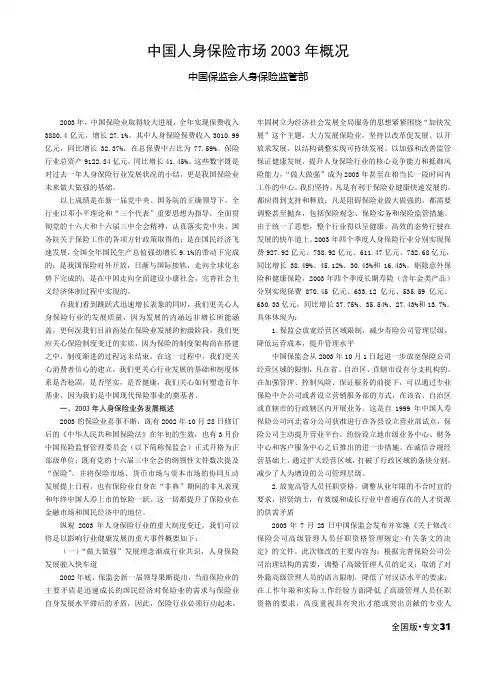
中国人身保险市场2003年概况中国保监会人身保险监管部2003年,中国保险业取得较大进展,全年实现保费收入3880.4亿元,增长27.1%。
其中人身保险保费收入3010.99亿元,同比增长32.37%,在总保费中占比为77.59%。
保险行业总资产9122.84亿元,同比增长41.45%。
这些数字既是对过去一年人身保险行业发展状况的小结,更是我国保险业未来做大做强的基础。
以上成绩是在新一届党中央、国务院的正确领导下,全行业以邓小平理论和“三个代表”重要思想为指导,全面贯彻党的十六大和十六届三中全会精神,认真落实党中央、国务院关于保险工作的各项方针政策取得的;是在国民经济飞速发展,全国全年国民生产总值强劲增长9.1%的带动下完成的;是我国保险对外开放,日渐与国际接轨,走向全球化态势下完成的;是在中国走向全面建设小康社会,完善社会主义经济体制过程中实现的。
在我们看到跳跃式迅速增长表象的同时,我们更关心人身保险行业的发展质量,因为发展的内涵远非增长所能涵盖,更何况我们目前尚处在保险业发展的初级阶段,我们更应关心保险制度变迁的实质,因为保险的制度架构尚在搭建之中,制度渐进的过程远未结束。
在这一过程中,我们更关心消费者信心的建立,我们更关心行业发展的基础和制度体系是否稳固,是否坚实,是否健康,我们关心如何塑造百年基业,因为我们是中国现代保险事业的奠基者。
一、2003年人身保险业务发展概述2003的保险业喜事不断,既有2002年10月28日修订后的《中华人民共和国保险法》在年初的生效,也有3月份中国保险监督管理委员会(以下简称保监会)正式升格为正部级单位;既有党的十六届三中全会的纲领性文件数次提及“保险”,并将保险市场、货币市场与资本市场的协同互动发展提上日程,也有保险业自身在“非典”期间的非凡表现和年终中国人寿上市的惊险一跃。
这一切都提升了保险业在金融市场和国民经济中的地位。
纵观2003年人身保险行业的重大制度变迁,我们可以将足以影响行业健康发展的重大事件概要如下:(一)“做大做强”发展理念渐成行业共识,人身保险发展驶入快车道2002年底,保监会新一届领导果断提出,当前保险业的主要矛盾是迅速成长的国民经济对保险业的需求与保险业自身发展水平滞后的矛盾,因此,保险行业必须行动起来,牢固树立为经济社会发展全局服务的思想紧紧围绕“加快发展”这个主题,大力发展保险业,坚持以改革促发展、以开放求发展、以结构调整实现可持续发展、以加强和改善监管保证健康发展,提升人身保险行业的核心竞争能力和抵御风险能力,“做大做强”成为2003年甚至在相当长一段时间内工作的中心。
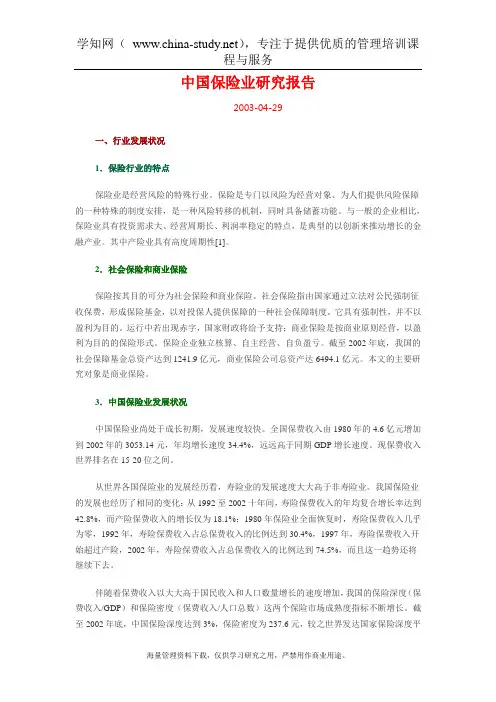
中国保险业研究报告2003-04-29一、行业发展状况1.保险行业的特点保险业是经营风险的特殊行业。
保险是专门以风险为经营对象、为人们提供风险保障的一种特殊的制度安排,是一种风险转移的机制,同时具备储蓄功能。
与一般的企业相比,保险业具有投资需求大、经营周期长、利润率稳定的特点,是典型的以创新来推动增长的金融产业。
其中产险业具有高度周期性[1]。
2.社会保险和商业保险保险按其目的可分为社会保险和商业保险。
社会保险指由国家通过立法对公民强制征收保费,形成保险基金,以对投保人提供保障的一种社会保障制度。
它具有强制性,并不以盈利为目的。
运行中若出现赤字,国家财政将给予支持;商业保险是按商业原则经营,以盈利为目的的保险形式。
保险企业独立核算、自主经营、自负盈亏。
截至2002年底,我国的社会保障基金总资产达到1241.9亿元,商业保险公司总资产达6494.1亿元。
本文的主要研究对象是商业保险。
3.中国保险业发展状况中国保险业尚处于成长初期,发展速度较快。
全国保费收入由1980年的4.6亿元增加到2002年的3053.14元,年均增长速度34.4%,远远高于同期GDP增长速度。
现保费收入世界排名在15-20位之间。
从世界各国保险业的发展经历看,寿险业的发展速度大大高于非寿险业。
我国保险业的发展也经历了相同的变化:从1992至2002十年间,寿险保费收入的年均复合增长率达到42.8%,而产险保费收入的增长仅为18.1%;1980年保险业全面恢复时,寿险保费收入几乎为零,1992年,寿险保费收入占总保费收入的比例达到30.4%,1997年,寿险保费收入开始超过产险,2002年,寿险保费收入占总保费收入的比例达到74.5%,而且这一趋势还将继续下去。
伴随着保费收入以大大高于国民收入和人口数量增长的速度增加,我国的保险深度(保费收入/GDP)和保险密度(保费收入/人口总数)这两个保险市场成熟度指标不断增长。
截至2002年底,中国保险深度达到3%,保险密度为237.6元,较之世界发达国家保险深度平均8%-10%、保险密度人均数千元美元的水平,我国保险有效需求明显不足,但同时也展现了我国保险业的广阔发展空间。
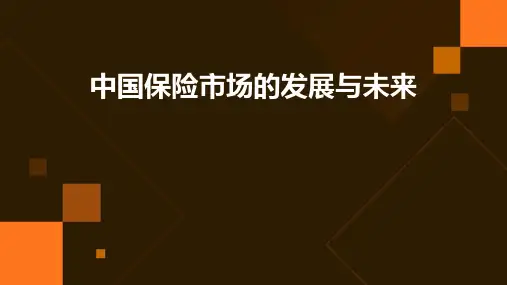
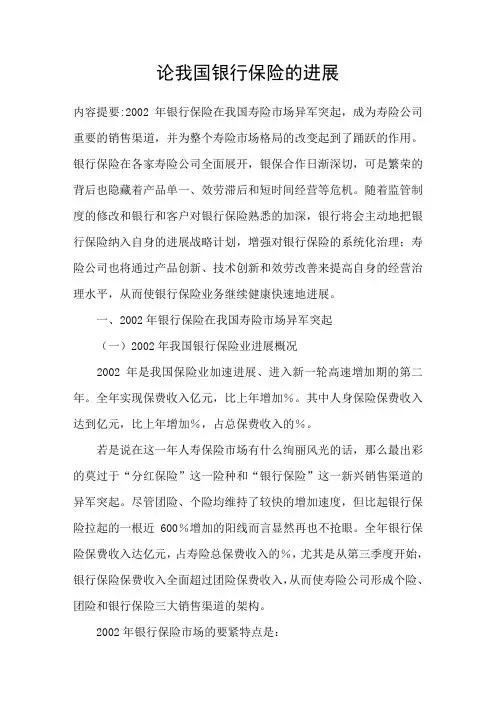
论我国银行保险的进展内容提要:2002年银行保险在我国寿险市场异军突起,成为寿险公司重要的销售渠道,并为整个寿险市场格局的改变起到了踊跃的作用。
银行保险在各家寿险公司全面展开,银保合作日渐深切,可是繁荣的背后也隐藏着产品单一、效劳滞后和短时间经营等危机。
随着监管制度的修改和银行和客户对银行保险熟悉的加深,银行将会主动地把银行保险纳入自身的进展战略计划,增强对银行保险的系统化治理;寿险公司也将通过产品创新、技术创新和效劳改善来提高自身的经营治理水平,从而使银行保险业务继续健康快速地进展。
一、2002年银行保险在我国寿险市场异军突起(一)2002年我国银行保险业进展概况2002年是我国保险业加速进展、进入新一轮高速增加期的第二年。
全年实现保费收入亿元,比上年增加%。
其中人身保险保费收入达到亿元,比上年增加%,占总保费收入的%。
若是说在这一年人寿保险市场有什么绚丽风光的话,那么最出彩的莫过于“分红保险”这一险种和“银行保险”这一新兴销售渠道的异军突起。
尽管团险、个险均维持了较快的增加速度,但比起银行保险拉起的一根近600%增加的阳线而言显然再也不抢眼。
全年银行保险保费收入达亿元,占寿险总保费收入的%,尤其是从第三季度开始,银行保险保费收入全面超过团险保费收入,从而使寿险公司形成个险、团险和银行保险三大销售渠道的架构。
2002年银行保险市场的要紧特点是:1.银行保险业务全面展开,但收成不一。
国内各家寿险公司都不约而同地把银行保险作为2002年新的业务增加点,银保合作此起彼伏。
如表1所示,各家寿险公司都分得了一杯羹,最引人注目的莫过于新成立的太平人寿保险公司,其依仗工商银行的背景收进了近12亿元的银行保险保费,该收入占其全年全公司保费收入的%,占比超过了目前银行保险发达的欧洲诸国。
2.银行与寿险公司的合作深度和广度加大。
目前全国大约有银行网点13万个左右,加上邮政储蓄网点也只是18万个上下,可是已经和寿险公司签定协议代理其业务的至少已经有近8万个,银行保险在网点上的覆盖面可见一斑。
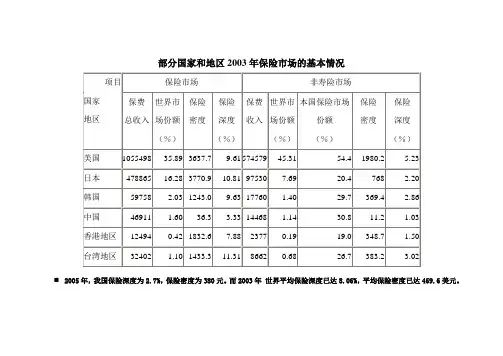
中国保险业2003年经营状况分析中国保险年鉴编辑部本篇分析报告从保费收入、预计利润和保险总资产等重要指标,对2003年全国保险业进行了主要突出量化的全面分析。
文中所依据的数字来源于各保险公司和各保监局的季度报表,因此,具有权威性。
2003年,在党中央、国务院的正确领导下,我国国民经济保持稳定增长。
国内生产总值实现116694亿元,比上年增长9.1%;全社会固定资产总投资55118亿元,增长26.7%;城镇居民人均可支配收入8472.2元,增长9.99%;居民消费物价指数上涨1.2%;城乡居民储蓄存款余额103618亿元,比年初增加16707亿元,增长19.22%。
国家对基础设施建设投资的增加,居民收入水平上升,为保险市场的发展创造了良好环境。
我国自1998年以来连续六年实行积极的财政政策和稳健的货币政策,也促进了保险行业的发展。
最近五年来全国保费收入平均增长水平为25.17%,保险深度由1.76%升至3.33%,保险密度由114.84元上升为287.44元。
(详见表一)表一:1999年至2003年保费收入情况单位:亿元2003年,全国保险市场承保总金额658011亿元,比上年增长23.36%;保费收入3880.40亿元,比上年增长27.1%;保险深度3.33%,比上年增长0.35个百分点;保险密度287.44元,比上年增加49.80元;保险行业总资产9122.84亿元,比上年增长40.46%。
一、2003年保险市场基本状况2003年,全国保费收入总计3880.40亿元,比上年增加826.25亿元,增长27.05%;。
按业务类型划分:财产保险保费收入869.40亿元,比上年增长11.53%,占市场份额22.40%;人身保险保费收入3010.99亿元,比上年增长32.37%,占市场份额77.59%。
按投资主体划分:中资保险公司保费收入3816.17亿元,比上年增长26.87%,占市场份额98.34%;外资、合资保险公司保费收入64.23亿元,比上年增长39.03%,占市场份额1.66%。
2001年初至今,国际保险市场经历了一段十分艰难的时期。
多年的市场疲软,加之日益激烈的竞争引起保费收入的持续下降,导致保险公司的承保业绩越来越差;而资本市场的恶化及利率的持续下调使得投资收益已不足以弥补承保亏损。
2002年,全国保费收入3053.1亿元,同比增长44.7%,改革开放以来,我国保险业保持了30%以上的增长速度。
但是必须看到,这是在较低水平上形成的高速度。
财产保险保费收入占保费收入的比重从1996年的58.27%降为1997年的44.67%直至2001年的32.5%。
其主要原因是银行存款利率下调、投资型险种增加,导致了人身保险保费收入大量增加。
在国内12家内资公司中,中国人寿保险公司和中国人民保险公司的保费收入市场占有率分别为38.51%、23.96%。
这说明多主体的市场格局虽然基本形成,但市场仍然属于寡头垄断型市场。
外资保险公司保费在总保费收入中的比重虽然不大,但在外资保险公司开展业务的地区所占的市场份额比重远远高于其所占总市场份额比重。
为了迎接加入WTO后激烈的市场竞争,国内的保险公司将纷纷谋求通过上市扩充实力。
此外,开始走向成熟的中小型保险公司正在对股本扩张产生的更大需求,吸引民间资本涉足。
1 保险行业概述 (1)1.1保险的作用及其分类 (1)1.2保险经营原则 (3)1.3保险行业的特点 (4)2 国际保险市场状况分析 (5)2.1保险价格大幅上扬 (5)2.2承保责任范围明显收紧 (7)2.3大型保险公司信贷部门经营困难。
(9)2.4再保险市场格局发生变化。
(9)2.5国际保险业发展趋势 (10)3. 中国保险行业发展情况分析 (15)3.1我国保险收入规模及变化 (15)3.2我国保险业险种结构变化 (17)3.2.1从财产保险业务为主转向人身保险业务为主 (17)3.2.2 保险业务的险种结构发生明显变化 (17)3.3保险业企业数量分析 (19)3.4中国保险行业面临的问题 (21)3.4.1 有效供给与有效需求不足 (21)3.4.2 寿险业面临较严重的利差损 (22)3.4.3 保险法规尚需进一步完善,保险监管有待加强 (22)3.4.4 保险业地区发展不平衡 (23)3.4.5 资本与财务问题 (23)3.4.6 技术和产品问题 (24)3.4.7 人才问题 (25)4. 2002年中国保险业运行情况分析 (27)4.1保费收入的变化 (27)4.2保险市场区域结构分析 (29)4.32002年我国保险业重大改革举措 (29)4.3.1《保险法》完成修改 (29)4.3.2 车险改革的准备工作 (30)4.3.3 国有公司准备股份制改革,股份制公司优化股权结构 (31)4.3.4 对外开放程度加大 (32)4.3.5 寿险营销员营业税问题获突破性进展 (32)4.3.6 两起重大空难及相关政策变化 (33)4.3.7 银行保险和分红保险的发展 (34)4.3.8 平安分业 (34)5 我国保险市场的发展变化及其趋势 (36)5.1市场主体变化分析 (36)5.1.1市场集中度仍然较高 (36)5.1.2 保险市场强势主体增加 (36)5.2WTO对中国保险业的挑战 (37)5.2.1 现代化的管理理念、先进的管理技术和手段的冲击 (38)5.2.2 保险商品优劣相比更加明显 (38)5.2.3 国外现代化金融体制使其更能满足客户需求 (39)5.3国内保险公司谋求上市和建立法人治理结构 (40)5.4民营资本介入保险市场 (41)5.4.1 参股介入 (41)5.4.2 直接组建民营保险 (42)5.4.3 民营与外资保险合资 (42)5.5加快保险企业产品与服务创新 (43)5.6扩大资金运用范围和综合经营 (43)5.8保险业与银行业、信托业的合作 (45)5.8.1 银保合作 (45)5.8.2 信保合作 (47)6 外资保险公司在华业务分析 (48)6.1外资公司在华业务现状及对策 (48)6.1.1 外资公司业务发展现状 (48)6.1.2 外资公司进入中国市场的策略分化 (52)6.2外资保险公司的竞争力分析 (52)6.2.1 外资保险的优势分析 (52)6.2.2 外资保险的劣势分析 (53)7 中国保险资金运用问题研究 (57)7.1保险公司拓宽投资渠道的必要性 (59)7.2中国保险业创新的投资方法 (59)7.2.1 投资型保险促投资 (59)7.2.2 保险投资适当渠道放宽 (60)7.2.3 保险投资队伍壮大 (60)7.3保险公司证券投资基金状况分析 (61)7.3.1 保险业投资证券投资基金总量增长 (61)7.3.2 基金投资更趋理性,小盘基金受到重视 (62)8. 行业经营状况 (64)8.1盈利能力 (64)8.2偿付能力 (65)9. 中国保险业投资价值分析 (67)9.1主要风险及成因分析 (67)9.1.2 新险种开发风险 (67)9.1.3 保险市场开放风险 (68)9.1.4 利差损风险 (69)9.1.5 电子网络风险 (69)9.2投资价值与投资机会分析 (71)表目录表1.1商业保险同社会保险的主要区别 (3)表1.2保险当事人的权利和义务 (4)表3.12001年全部保险公司险种结构 (17)表3.21999—2001年财产险主要险种保费收入结构变化对比 (18)表3.31999~2001年人身险主要险种保费收入结构变化对比 (18)表3.41999年—2002年保险机构数量变化 (19)表3.5保险公司专业人员的职能 (25)表4.12002年保费收入情况 (27)表4.21999—2001年财产险主要险种保费收入结构变化对比 (28)表4.3中国历年保险深度和保险密度 (29)表6.12000、2001年各外资保险公司资金运用收益率 (50)表7.12000、2001年主要投资品种收益率 (58)表8.1部分保险公司的盈利能力分析(2001年) (64)表8.2财产保险与人身保险的主要区别: (65)表8.3各保险公司的资本充足率状况(2001年) (66)图目录图1.1保险业的分类 (2)图3.1我国1996—2001年人身险与财产险比重变化 (15)图3.21999年—2002年保费收入情况 (15)图3.31999年—2002年人身险保费收入情况 (16)图3.41999年—2002年财产险保费收入情况 (16)图4.12002年末人身险保费收入分布情况 (28)图4.22002年末人身险给付分布 (28)图6.1外资保险公司进入中国保险市场情况 (48)图7.12001年保险投资结构 (58)2003年保险业投资分析报告1 保险行业概述保险是集合具有同类危险的众多单位和个人,以合理计算分担金的形式,实现对少数成员因该危险事故所导致的经济损失的补偿行为,用通俗的话讲就是“集众人之小财,救一人之大灾”。
深入贯彻十六大精神努力开创保险业发展的新局面——吴定富主席在2003年全国保险工作会议上的讲话同志们:这次会议是在各行各业深入学习贯彻十六大精神,全面建设小康社会的新形势下召开的。
会议的主要任务是:进一步学习贯彻十六大和中央经济工作会议精神,统一思想,提高认识,总结去年的工作,分析面临的形势,明确今年的工作任务。
下面,我讲几点意见,供大家讨论。
一、2002年保险业的基本情况去年,在党中央、国务院的正确领导下,保险业认真贯彻落实全国金融工作会议精神,努力实践“三个代表”重要思想,各项工作都取得了明显成绩。
(一)保险业务快速增长。
去年是近年来业务增长速度最快的一年。
全国保费收入3053.1亿元,同比增长44.7%。
其中,财产险保费收入778.3亿元,同比增长13.6%;人身险保费收入2274.8亿元,同比增长59.8%。
保险深度3%,同比增加0.8个百分点;保险密度237.6元,同比增加68.8元。
保险公司总资产6494.1亿元,比上年末增长41.4%。
共支付赔款和给付706.7亿元,同比增长18.1%。
特别是在“4.15”和“5.7”空难事故及部分地区洪涝灾害发生后,保险公司及时赔付,切实发挥了保险的经济补偿作用。
(二)改革创新不断推进。
国有保险公司体制改革工作取得突破性进展。
中国人民保险公司和中国人寿保险公司的股份制改革方案已获国务院批准。
中国再保险公司的股份制改革方案也已上报国务院。
股份制保险公司进一步优化股权结构。
太平保险公司、华泰保险公司和平安保险公司分别引入海外战略投资者,太平洋保险公司完成了增资扩股。
产品和销售渠道的创新促进了业务发展。
寿险分红产品保费收入1121.7亿元,占人身险保费收入的49.3%,成为新的业务增长点。
银行代理寿险保费收入388.4亿元,占人身险保费收入的17.1%,银行代理已成为寿险的主要销售渠道之一。
(三)对外开放进一步扩大。
去年是我国加入世贸组织的第一年,也是保险市场对外开放步伐最快的一年。
中国保险行业发展展望一、保险行业发展概况分析伴随着中国经济的起飞,中国保险业的发展势头一发不可收。
数据显示,中国保险业的年保费收入从复业之后1980年的4.6亿元,增加到2017年的36581亿元,年均增长速度27.5%,这一速度无疑令人咋舌。
1992年全国只有6家保险公司,但截至2018年底,我国保险机构数量达235家,保费收入和总资产分别为3.8万亿元、18.33万亿元,保险密度2724元/人,保险深度4.22%,保险营销员队伍超过800万人。
保险市场规模先后超过德国、法国、英国、日本,全球排名升至第二位,在世界500强中有7家中国内地的保险公司,成为全球最重要的新兴保险市场大国。
保险业发展的同时,我国的互联网经济也在飞速发展,它们碰撞出的互联网保险渠道成为前几年保险市场上的一抹亮色。
根据统计数据显示,截止至2017年中国互联网保险保费收入下降至1875.27亿元,同比下降20.1%。
初步测算2018年中国互联网保险保费收入达到了1889亿元左右。
但近两年,由于针对中短存续期产品的强监管以及商业车险费改的影响,互联网渠道的产、寿险保险收入纷纷出现负增长,2017年上半年分别下滑20.01%及10.9%,2018年上半年披露的人身险互联网保险保费收入再次下滑15.61%。
对于互联网渠道的前景观点各异,不过行业内形成的共识是,互联网科技浪潮所演化出的保险科技将改变保险业传统的模式,重塑保险业的未来,也将成为保险业接下来的主要战场之一。
二、财产险和寿险受疫情影响较大2019年我国健康险保费收入为7066亿元,同比增长29.70%,原保险保费收入为42645亿元,同比增加12.18%。
2003年非典期间,我国健康险的收入增速加快。
同非典一样,此次新冠病毒得到控制或结束之后,我国健康险的收入增速极有可能大幅提高,同时带动整个保险业业绩的增长。
2020年春节,新型冠状病毒感染肺炎疫情席卷全国。
为了抗击疫情的发展,需要降低人口的流动和聚集,因此国内消费需求大幅降低。
论中国保险业发展现状论中国保险业发展现状改革开放以来,中国保险业的发展与对外开放取得了一系列成果。
特别是中国加入世贸组织以后,保险业逐渐进入全面开放的新时期,形成了中外资保险公司良性互动、共同发展的局面。
随着中国社会主义市场经济体制的逐步完善,作为金融三大支柱之一的保险业将具有更为广阔的发展前景。
中国保险业在开放中不断发展壮大第一,业务快速发展。
自1980年恢复国内保险业务以来,中国的保险业保持了持续快速、健康发展的良好势头。
2003年保费总收入达到3880.4亿元,比上年增长27.1%,相当于1999年的2.8倍;保险业总资产达到9122.8亿元,比上年增长41.5%;保险资金运用余额达到8739亿元,比上年增长51.4%。
2003年保险密度为287.44元(即每个公民的平均保费),保险深度为3.33%,中国保险业呈现出蓬勃发展的良好局面。
第二,市场体系逐步健全。
截至2003年底,全国共有保险公司61家,其中中资保险公司24家,外资保险公司37家。
按业务性质分,财产保险公司25家,人身保险公司30家,再保险公司5家,政策性保险公司1家。
此外还有6家保险集团(控股)公司,2家保险资产管理公司。
专业保险中介机构705家,其中保险代理公司507家,保险经纪公司115家,保险公估公司83家,保险从业人员达到150万人。
第三,体制改革进展顺利。
中国人民保险公司、中国人寿保险公司、中国再保险公司等国有保险公司股份制改革取得了重大进展。
2003年11月6日,中国人民财产保险股份有限公司在香港联交所挂牌上市,募集资金62.2亿港元。
2003年12月17日、18日中国人寿保险股份有限公司在纽约和香港同步上市,募集资金34.75亿美元。
部分股份制保险公司通过吸收外资和民营资本参股,股权结构得到优化,治理结构逐步完善,经营管理水平进一步提高。
保险资金运用管理体制改革取得突破。
经国务院批准,中国人保控股公司和中国人寿保险集团公司分别设立了保险资产管理公司,把保险资金实行了专业化管理和集中统一运用。
中国保险市场2003年概况及展望中国保险监督管理委员会主席一、2003年保险业基本情况2003年,在党中央、国务院的正确领导下,保险业认真贯彻落实“三个代表”重要思想和十六大精神,以改革促发展,以开放求发展,以结构调整实现可持续发展,以加强和改善监管促进健康发展,较好地完成了全国保险工作会议部署的各项任务,在全行业上下形成了抓改革、促发展的良好氛围。
全国保费收入3880.4亿元,同比增长27.1%。
其中,财产险保费收入869.4亿元,同比增长11.7%;寿险保费收入2669.5亿元,同比增长28.7%;健康及意外险保费收入341.5亿元,同比增长69.7%。
保险密度287.44元,保险深度 3.33%。
保险公司总资产达到9122.8亿元,同比增长41.5%。
截至2003年底,全国共有保险公司61家,其中财产险公司24家(政策性保险公司1家),人身险公司32家,再保险公司5家;其他保险机构8家,其中集团(控股)公司6家,资产管理公司2家;保险中介公司1037家,其中已批准开业706家(经纪公司83家,公估公司115家,代理公司508家),待开业331家(经纪公司82家,公估公司43家,代理公司206家)。
各保险公司通过保险中介(包括保险营销员、兼业代理、保险代理公司、保险经纪公司,由于保险营销员的归属待定,目前暂将保险营销员列入保险中介系列)渠道的保费收入为2892.73亿元,占全国总保费收入的74.55%。
其中保险营销员保费收入1612.83亿元,占全国总保费收入的41.56%;兼业代理保费收入1183.51亿元,占全国总保费收入的30.50%;保险经纪公司保费收入49.60亿元,占全国总保费收入的1.28%;保险代理公司保费收入46.78亿元,占全国总保费收入的1.21%。
全国共有保险从业人员150万人,保险代理人128万人。
保险业呈现出蓬勃发展的良好局面。
(一)学习实践“三个代表”重要思想和十六大精神在认识上达到新高度按照党中央的统一部署,全行业迅速兴起学习贯彻“三个代表”重要思想的新高潮,紧密结合保险业实际,在解放思想中统一思想,认识上达到新高度。
主要表现在:思想观念发生深刻变化。
一是政治意识明显增强。
坚持正确的政治方向,从政治的高度认识和处理问题,坚决贯彻执行党中央、国务院关于保险工作的重大方针和工作部署。
出台的政策措施,推出的产品服务,都把维护最广大人民群众的根本利益作为出发点和落脚点;二是大局意识明显增强。
牢固树立想全局、干本行,干好本行、服务全局的意识,紧紧围绕党和国家的中心任务开展工作,努力发挥保险业促进改革、保障经济、稳定社会、造福人民的作用;三是责任意识明显增强。
深刻认识到我国保险业基础差、底子薄,地区发展不平衡,总体发展水平低,同经济社会发展和群众生活的需求相比还有很大差距,增强了加快发展的紧迫感和责任感。
保险理论创新取得成果。
以“三个代表”重要思想为根本指针,结合我国保险业实际,积极探索具有时代特点和中国特色的保险发展道路,对如何认识我国保险业、怎样发展我国保险业、发展一个什么样的保险业等基本问题有了更加深刻的认识。
一是作出了我国保险业仍处于发展初级阶段的重要判断,基本特征是总体规模小,在国民经济中的比重低,功能和作用发挥不充分;二是提出了当前保险业的主要矛盾是发展水平与国民经济、社会发展和人民生活的需求不相适应;三是明确了保险业的首要任务是加快发展,尽快做大做强;四是发展了保险功能理论,提出现代保险不仅具有经济补偿功能和资金融通功能,还具有社会管理功能,为保险业全方位、多层次、宽领域挖掘发展潜力,拓宽发展空间提供了理论指导。
对我国保险业发展规律有了进一步的认识和把握。
总结改革开放20多年来保险业发展的经验,适应新形势、新任务,对社会主义市场经济条件下保险业发展规律的认识不断深化,提出了要处理好八个方面的关系。
一是处理好保险业与经济社会的关系,必须将保险业置身于经济和社会发展的全局,自觉服从经济和社会发展的需要;二是处理好经济效益与社会效益的关系,实现经济效益与社会效益的有机统一;三是处理好保险业做大与做强的关系,既要做大又要做强,不断提高保险业整体实力和竞争能力;四是处理好加强监管与加快发展的关系,寓监管于服务之中,为发展创造良好环境;五是处理好加快发展与防范风险的关系,既不能因为有风险而不敢发展,也不能为了发展而不顾风险;六是处理好发达地区和欠发达地区保险市场发展的关系,鼓励东部沿海发达地区继续保持良好的发展势头,加快中西部等欠发达地区保险业发展;七是处理好加强监管与鼓励创新的关系,保险监管部门既要支持和鼓励保险创新,又要努力防范化解创新可能带来的风险;八是处理好长远与当前的关系,克服短期行为,开发好、利用好、保护好保险资源,实现保险业可持续发展。
(二)体制改革取得重大突破为解决保险业发展中的体制性障碍,不断深化改革,增强加快发展的动力。
国有保险公司改革取得重要进展。
保监会把推动国有保险公司股份制改革作为监管创新的重要举措和防范风险的治本之策,列为全年工作的重中之重,有效发挥指导、监督和协调的作用。
国有保险公司认真贯彻落实国务院批准的股份制改革方案,一手抓改革,一手抓发展,克服非典疫情和国际资本市场波动带来的不利影响,克服时间紧、任务重、要求高,又没有现成经验可以借鉴的实际困难,大胆探索,努力工作,积极推进股份制改革。
中国人保、中国人寿和中国再保险三家公司全部完成重组改制工作。
中国人民财产保险股份有限公司在香港上市,成为第一家在境外上市的国有金融企业。
中国人寿保险股份有限公司在纽约和香港两地同步上市,创造了当年全球资本市场首次公开发行融资额的最高纪录。
通过上市,两家公司共筹集资金折合人民币354亿元,增强了资本实力,提高了偿付能力和抵御风险的能力,优化了股权结构,为进一步转换经营机制,提高竞争能力奠定了坚实基础。
股份制保险公司通过吸收外资和民营资本参股,引进境外战略投资者,逐步优化股权结构,发挥外资和民营股东在完善公司治理结构和加强内控建设方面的积极作用,切实在转换经营机制上下功夫,企业的竞争力进一步提高。
保险资金运用管理体制改革取得突破。
经国务院批准,中国人保控股公司和中国人寿保险(集团)公司设立保险资产管理公司,对保险资金实行专业化管理和集中统一运用,在探索保险资金管理体制改革方面迈出重要步伐。
(三)推出一系列促进发展的举措保监会坚持市场化原则,出台了一系列加快发展的政策措施,努力为市场主体服务,创造良好发展环境。
一是稳步推进条款费率管理制度改革。
车险条款费率管理制度改革在全国范围内推开,经过大量深入细致的工作,市场运行基本平稳。
航空意外险改革稳步推进。
通过改革,保险公司更加尊重市场规律,注重产品开发和客户服务。
保险产品种类逐步增加,费率趋于合理,较好地满足了社会需求。
二是放宽中资保险公司分支机构经营区域。
凡在省、自治区、直辖市设有分支机构的,可以通过专业保险中介公司或者设立营销服务部的方式在该行政辖区内开展业务,改变了部分地区经营主体偏少的局面,促进了市场竞争。
三是放宽保险公司高级管理人员任职资格限制。
在从业年限、工作经历以及高管人员的任职审批范围等方面做了合理调整,为保险公司吸引人才,提高保险从业人员整体素质创造了条件。
四是拓宽保险资金运用渠道。
保险公司投资企业债券的范围由4个行业扩大到所有AA级以上的企业债券,投资比例由不超过总资产的10%提高到20%。
五是完善市场准入机制,增加经营主体。
支持股份制保险公司发展服务网点,把保险中介机构审批纳入日常工作程序,共批设保险公司分支机构316个,保险专业中介机构922家。
六是努力拓宽保险服务领域。
通过举办企业年金论坛、健康险论坛、现代保险功能论坛,联合开展地震保险、农业保险等重大理论和实践课题研究等多种方式,积极与有关部委加强沟通协调,取得他们对保险业改革发展的理解和支持,推动业务的发展。
七是发挥新闻宣传的作用,为保险业发展营造良好的舆论环境。
加强对行业宣传工作的指导,建立了保监会新闻发言人制度。
保险新闻报道坚持正确的舆论导向,服务于保险业改革发展的大局,取得明显宣传效果,扩大了保险的社会影响。
据不完全统计,2003年仅中央和首都的新闻单位采写的保险新闻报道就4000多篇。
八是积极争取各级政府对保险业发展的支持。
保监会派出机构主动向地方政府汇报工作,得到地方政府重视。
四川、湖南省政府还把保险业发展纳入当地经济社会发展总体规划,并制定了促进保险业发展的指导意见。
各保险公司改革发展迈出新步伐。
一是制定科学的发展战略,积极调整业务结构,加大产品开发力度,效益观念明显增强;二是适应业务发展需要,增设分支机构,服务网络布局更加合理,服务功能不断增强;三是加强内部管理,强化业务和财务风险控制。
在改革发展的基础上,大多数保险公司保持了较高的业务增长速度和良好的发展势头,其中新华人寿、泰康人寿和太平人寿等公司的保费收入都翻了一番。
(四)保险的作用得到较好发挥,保险业的社会地位进一步提高保险业立足为经济社会发展全局服务,努力发挥保险的各项功能和作用,取得明显成绩。
在经济补偿方面,2003年各保险公司共支付赔款和给付841亿元,同比增长19%,特别是在一些重大灾害事故发生后,保险公司及时赔付,在灾后重建、恢复正常的生产生活秩序方面发挥了重要作用。
如淮河流域水灾赔付5亿多元,上海地铁4号线透水事故预赔1.35亿元。
出口信用保险公司成立两年来,为70多亿美元的出口和投资提供收汇保障,为40多项大型中长期外贸及投资项目提供保险支持,向企业支付赔款1亿多美元,较好地发挥了支持对外贸易的作用。
在资金融通方面,截至2003年底,保险资金运用余额8225亿元,为国家经济建设提供了大量资金。
其中,4560亿元存入银行,1370亿元购买国债。
保险公司持有的企业债券占企业债券总量的一半,持有的证券投资基金占整个证券市场基金额的26.3%,保险公司已成为资本市场主要的机构投资者,为资本市场的发展和稳定发挥了积极作用。
在发挥社会管理功能方面,各保险公司普遍加强了防灾防损和社会保障等方面的服务,保险承担起更多的社会责任。
特别是在抗击非典斗争中,保险业反应快、介入早,共向313例非典患者赔付500多万元,向社会捐款1000多万元,向医护人员捐赠保险保额2亿多元,树立了负责任、献爱心的行业形象,表现出“服务大局、勇担责任、团结协作、为民分忧”的行业精神,增强了全社会战胜非典的信心,得到社会普遍认可。
随着保险作用的进一步发挥,社会对保险的认识逐步加深,保险业的社会影响日益扩大。
一是保险业的发展得到了党中央、国务院的高度重视。
温家宝总理和黄菊副总理多次对保险工作作出重要批示,提出明确要求。
黄菊同志还亲自出席国有保险公司股份制改革工作座谈会并作重要讲话。